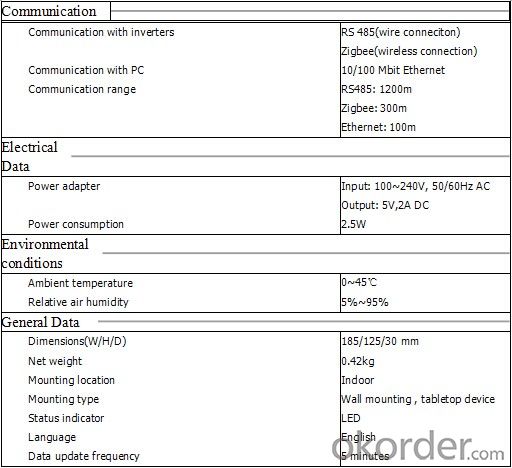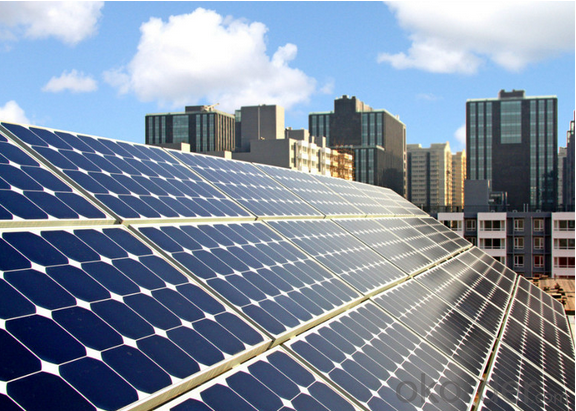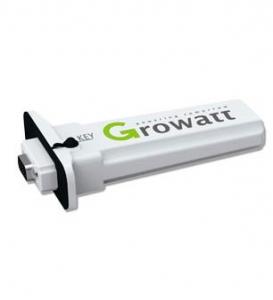Shine Wi-Fi, Solar System Monitoring, Remote Control
- Loading Port:
- Shekou
- Payment Terms:
- TT OR LC
- Min Order Qty:
- 100 watt
- Supply Capability:
- 1000000 watt/month
OKorder Service Pledge
OKorder Financial Service
You Might Also Like
Shine Wi-Fi, Solar System Monitoring, WIFI
Professional monitor through Internet and environment
100-meter wireless connection to inverter
Easy-to use
Every inverter installed with Wi-Fi can be monitored in your own project
Remote setting and updating
Cost-effective


FAQ
Is solar power difficult to use?
Although the production of solar panels incorporates a high-tech manufacturing process, it is really very easy to use a photovoltaic system. Solar panels have no moving parts to wear out, they can be used alone or in combination with other energy sources, and they are silent, reliable and long lasting.
What can you power with Photovoltaics?
A properly designed photovoltaic system can supply electricity for many applications, from small remote lighting needs to megawatts of power for large utility companies. An advantage of photovoltaic power is that it can do anything a traditional power generator can do, only without consuming pollution-causing fuel, or requiring noisy motors.
What is a PV system?
A PV system consists of all the equipment and materials needed to generate solar energy, including solar panels (often called modules), a support structure, wiring, an inverter, a meter and other equipment as required by a specific application. JUST-SOLAR's PV system for commercial buildings, and ET Solar system for residential uses are examples of complete PV systems.
What is a solar module?
Solar modules are series of solar cells, wired together and enclosed protect them from the environment. They are often referred to as in self-contained glass units to solar panels as well.
How do solar cells work?
Solar cells are solid-state devices in which photons (or packets of light) collide with atoms. This process transforms the resulting into electrons. These electrons flow into wires connected to the cell, thus providing electric current to appliances, lighting systems or other electrical loads; and all of the power comes directly from the sun.
What is Photovoltaic Power?
Photovoltaic (PV) power is a term used to describe the process of converting sunlight into electricity with solar cells. These cells are specially constructed from semiconductor materials, and are treated to generate a flow of electricity when sunlight shines on them
- Q:How does a solar inverter handle grid faults or disturbances?
- A solar inverter handles grid faults or disturbances by continuously monitoring the grid voltage and frequency. When a fault or disturbance is detected, the solar inverter quickly disconnects from the grid to ensure safety and protect the system. It then enters a standby mode until the grid returns to normal conditions. Once the grid stabilizes, the solar inverter reconnects and resumes its normal operation of converting solar energy into usable electricity.
- Q:Are there any noise or sound considerations with a solar inverter?
- Yes, there are noise considerations with a solar inverter. While solar inverters typically produce low levels of noise, it is important to ensure that the inverter is placed in a well-ventilated area to avoid any potential fan or cooling system noise. Additionally, some older models of inverters may produce a slight humming sound during operation, although newer models have significantly reduced this noise.
- Q:What is the role of a solar inverter in reactive power compensation during grid disturbances?
- The role of a solar inverter in reactive power compensation during grid disturbances is to regulate and stabilize the flow of reactive power from the solar panels to the grid. During grid disturbances, such as voltage fluctuations or power imbalances, the inverter adjusts the reactive power output to maintain grid stability and improve power quality. By injecting or absorbing reactive power as needed, the solar inverter helps to maintain the grid voltage within acceptable limits and minimize disruptions in the power supply.
- Q:Do I need a special inverter for a battery storage system?
- Yes, a special inverter is required for a battery storage system. Unlike traditional grid-tied solar systems, a battery storage system needs an inverter that is capable of converting the direct current (DC) power produced by the batteries into alternating current (AC) power that can be used to power household appliances or fed back into the electrical grid.
- Q:How does a solar inverter handle different temperature conditions?
- A solar inverter is designed to handle different temperature conditions by incorporating various features and mechanisms. Firstly, it is equipped with a temperature sensor that continuously monitors the inverter's internal temperature. If the temperature exceeds a certain threshold, the inverter activates cooling mechanisms such as fans or heatsinks to dissipate the heat and prevent overheating. Additionally, the inverter's components are selected and designed to withstand a wide range of temperatures, ensuring their functionality and longevity even in extreme conditions. Furthermore, modern inverters often have built-in protective measures like thermal derating, which reduces the inverter's power output as the temperature rises, ensuring it operates within safe limits. Overall, solar inverters are engineered to adapt and operate efficiently in varying temperature conditions for optimal performance and reliability.
- Q:How does a solar inverter affect the voltage stability of a solar system?
- A solar inverter plays a crucial role in maintaining voltage stability in a solar system. It converts the direct current (DC) generated by solar panels into alternating current (AC) suitable for use in homes and businesses. By monitoring and adjusting voltage levels, a solar inverter ensures that the power output remains consistent and within acceptable limits. This helps to prevent voltage fluctuations, voltage drops, and other electrical instabilities, ensuring a stable and reliable power supply from the solar system.
- Q:What is the importance of overcurrent protection in a solar inverter?
- Several reasons highlight the significance of overcurrent protection in a solar inverter. Firstly, the conversion of direct current (DC) generated by solar panels into alternating current (AC) to power electrical devices is the responsibility of solar inverters. Throughout this conversion process, there is a potential risk of an overcurrent situation occurring, wherein the inverter surpasses its rated capacity. The consequences of such a scenario include overheating, damage to inverter components, and even fire hazards. Secondly, overcurrent protection is crucial for safeguarding the entire solar power system. By promptly detecting and interrupting excessive current flow, it prevents harm to solar panels, the inverter, and other connected electrical equipment. Additionally, it serves as a defense against electrical shocks and other potential hazards that may arise from an overcurrent situation. Furthermore, the maintenance of efficiency and performance in the solar inverter heavily relies on overcurrent protection. When an overcurrent event occurs, the inverter has the capability to shut down or reduce its output, effectively preventing further damage. This proactive approach ensures minimal downtime and guarantees the solar power system continues to function at its optimum capacity. Moreover, meeting regulatory and safety standards is another essential aspect of overcurrent protection. Various countries and regions have specific guidelines and requirements governing the installation and operation of solar power systems. Adhering to these standards is essential to ensure personnel safety, protect the environment, and mitigate any potential legal or financial liabilities. In conclusion, the safety, efficiency, and performance of the entire solar power system heavily rely on the presence of overcurrent protection in a solar inverter. It prevents damage to the inverter and other equipment, safeguards against hazards, and ensures compliance with regulatory standards. Consequently, implementing reliable and effective overcurrent protection mechanisms in solar inverters is imperative.
- Q:What is the role of an anti-islanding function in a solar inverter?
- The role of an anti-islanding function in a solar inverter is to ensure the safety of utility workers and prevent damage to the grid during a power outage. It detects if the grid is down and immediately disconnects the solar system from the grid, preventing the solar inverter from continuing to operate and potentially backfeeding electricity into the grid. This functionality is crucial in maintaining grid stability and protecting personnel working on the power lines.
- Q:How does a solar inverter handle voltage sags or swells in the grid?
- A solar inverter handles voltage sags or swells in the grid by continuously monitoring the grid voltage. When a sag or swell is detected, the inverter adjusts its output voltage accordingly to maintain a stable and consistent supply of power. It does this by regulating the amount of power it injects into the grid or by temporarily disconnecting from the grid to protect itself and other connected devices. This helps to prevent damage to the inverter and ensures that the solar system can continue operating efficiently even during voltage fluctuations.
- Q:Can a solar inverter be used with a monitoring system?
- Yes, a solar inverter can be used with a monitoring system. In fact, many solar inverters are equipped with built-in monitoring capabilities, allowing users to track the performance and output of their solar energy system in real-time. Additionally, there are also external monitoring systems available that can be integrated with a solar inverter to provide more advanced monitoring features and data analysis.
1. Manufacturer Overview |
|
|---|---|
| Location | |
| Year Established | |
| Annual Output Value | |
| Main Markets | |
| Company Certifications | |
2. Manufacturer Certificates |
|
|---|---|
| a) Certification Name | |
| Range | |
| Reference | |
| Validity Period | |
3. Manufacturer Capability |
|
|---|---|
| a)Trade Capacity | |
| Nearest Port | |
| Export Percentage | |
| No.of Employees in Trade Department | |
| Language Spoken: | |
| b)Factory Information | |
| Factory Size: | |
| No. of Production Lines | |
| Contract Manufacturing | |
| Product Price Range | |
Send your message to us
Shine Wi-Fi, Solar System Monitoring, Remote Control
- Loading Port:
- Shekou
- Payment Terms:
- TT OR LC
- Min Order Qty:
- 100 watt
- Supply Capability:
- 1000000 watt/month
OKorder Service Pledge
OKorder Financial Service
Similar products
New products
Hot products
Related keywords






























